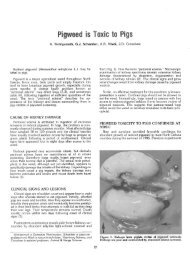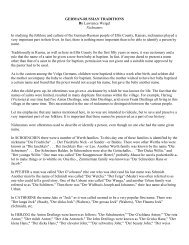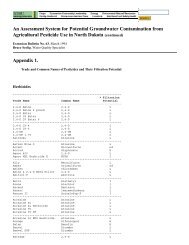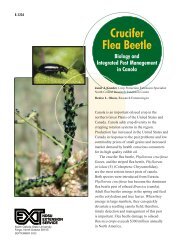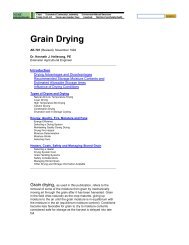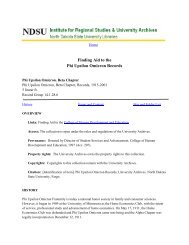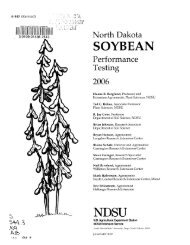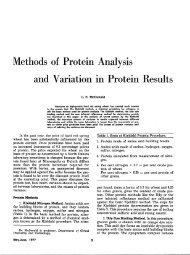germans from russia in fort collins, 1900-2000 - Libraries
germans from russia in fort collins, 1900-2000 - Libraries
germans from russia in fort collins, 1900-2000 - Libraries
Create successful ePaper yourself
Turn your PDF publications into a flip-book with our unique Google optimized e-Paper software.
INTRODUCTION<br />
Second Hoe<strong>in</strong>g, Second Look<br />
Hannah rejoiced as she watched Shag Town – one-room shacks with stove pipe chimneys<br />
stick<strong>in</strong>g out of the flat roofs at crazy angles, their weathered sides hugg<strong>in</strong>g the dirt yards, sagg<strong>in</strong>g<br />
fences hemm<strong>in</strong>g <strong>in</strong> dirty faced children – slowly slide beh<strong>in</strong>d her. All drab, colorless, with<br />
here and there a brightly pa<strong>in</strong>ted house, a good fence, only add<strong>in</strong>g to the sordidness of the<br />
scene.<br />
Separated <strong>from</strong> Shag Town by a dirt road were the st<strong>in</strong>k<strong>in</strong>g pulp pits adjo<strong>in</strong><strong>in</strong>g the manyw<strong>in</strong>dowed,<br />
red-brick sugar factory – gray, ferment<strong>in</strong>g noodles of shredded sugar beets <strong>from</strong><br />
which all the sweetness had been taken. Beyond was a high gray smokestack and the black<br />
water tower on its four spraddl<strong>in</strong>g legs.<br />
– Hope Williams Sykes, Second Hoe<strong>in</strong>g, 1935 1<br />
From the apartment beh<strong>in</strong>d her husband’s<br />
fill<strong>in</strong>g station, Hope Williams Sykes<br />
peered out upon a foreign and <strong>in</strong>trigu<strong>in</strong>g<br />
landscape. To the west, the Front Range of<br />
the Rocky Mounta<strong>in</strong>s jutted skyward <strong>from</strong><br />
the high prairie, reach<strong>in</strong>g to the snowy summit<br />
of Longs Peak. To the east stretched sugar<br />
beet fields, seem<strong>in</strong>gly <strong>in</strong>f<strong>in</strong>ite <strong>in</strong>to the horizon.<br />
Between them, loom<strong>in</strong>g massive, was<br />
the sugar beet factory. From its tall, brick<br />
chimney, smoke and soot created an everexpand<strong>in</strong>g<br />
and darken<strong>in</strong>g cloud. Around the<br />
ref<strong>in</strong>ery were mounta<strong>in</strong>s of beets and streams<br />
of steam<strong>in</strong>g, fetid effluence. Yet <strong>in</strong> this confused<br />
terra<strong>in</strong> of awe-<strong>in</strong>spir<strong>in</strong>g vistas and<br />
<strong>in</strong>dustrialized agriculture, Sykes was most<br />
<strong>in</strong>terested <strong>in</strong> the people resid<strong>in</strong>g <strong>in</strong> two small<br />
settlements at the foot of the factory – like<br />
villages surround<strong>in</strong>g a medieval castle. To her<br />
and many of her fellow Englische <strong>in</strong> Fort<br />
Coll<strong>in</strong>s, the residents of Buck<strong>in</strong>gham and<br />
Andersonville – the “Jungles” – were a<br />
conundrum. They spoke German but came<br />
<strong>from</strong> Russia. They ma<strong>in</strong>ta<strong>in</strong>ed dist<strong>in</strong>ctively<br />
German traditions while donn<strong>in</strong>g dist<strong>in</strong>ctively<br />
Russian apparel. Whether they were actually<br />
German or Russian did not matter to<br />
some of their neighbors across the Cache la<br />
Poudre River; they were all “dirty<br />
Rooshuns.” But among Fort Coll<strong>in</strong>s’s<br />
German-Russian community, identity was<br />
never a matter of confusion. They referred to<br />
themselves simply as unser Lait or unsere<br />
Leute – “our people.” 2<br />
Sykes chronicled her observations <strong>in</strong> the<br />
novel Second Hoe<strong>in</strong>g. Published <strong>in</strong> 1935, the<br />
book followed the life of a fictional German-<br />
Russian family between 1924 and 1929. Set<br />
<strong>in</strong> Valley City, a pseudonym for Fort Coll<strong>in</strong>s,<br />
the story follows a common trend among the<br />
beet-labor<strong>in</strong>g families: the rise <strong>from</strong> contract<br />
field laborers to tenant farmers to farm owners.<br />
The family’s move out of the Jungles to a<br />
rented farm represented one step <strong>in</strong> the pursuit<br />
of success. While hailed by critics,<br />
Second Hoe<strong>in</strong>g disturbed the German-<br />
Russian community because it describes brutality<br />
<strong>in</strong> an oppressively patriarchal family.<br />
A NOTE ON TERMS<br />
The confusion between the ethnicity of<br />
Germans <strong>from</strong> Russia and their orig<strong>in</strong><br />
has led to a proliferation of terms to<br />
describe this group. Texts refer to<br />
them as German Russians, Russian<br />
Germans, Volga Germans, and<br />
Germans <strong>from</strong> Russia. The last term is<br />
perhaps the most accurate and is<br />
widely used <strong>in</strong> this document.<br />
However, for the sake of simplicity I<br />
also use German Russian on occasion,<br />
hyphenat<strong>in</strong>g the term only when it is<br />
used as a compound modifier. The<br />
term Volga German should be avoided<br />
as a general reference to Germans<br />
<strong>from</strong> Russia because it neglects the<br />
huge number of Germans who came<br />
to the United States <strong>from</strong> the Black<br />
Sea colonies. However, <strong>in</strong> specific references<br />
to northern Colorado I do<br />
use the term because the vast majority<br />
of Germans <strong>from</strong> Russia who settled<br />
here orig<strong>in</strong>ated <strong>from</strong> the Volga<br />
colonies.<br />
Page iii



